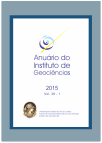Evaluation of Seasonal Ensemble Precipitation Hindcasts at Upper São Francisco River in Brazil
DOI:
https://doi.org/10.11137/2015_2_24-36Keywords:
Seasonal forecasting, Precipitation, Eta model, Minas GeraisAbstract
Seasonal rainfall forecasts generated with regional Eta model for the rainy season of the São Francisco River Basin, upstream Hydroeletric Power Plant (HPP) Três Marias in Minas Gerais are evaluated in this work. The use of such forecasts as an input in energy planning models, represent a better management in the generation, transmission and distribution of electricity. However, it is well known that most of the globe, seasonal climate predictability is much reduced, since the effects of boundary conditions to determine the evolution of the average state of the atmosphere compete with internal variability associated with the chaotic instabilities and nonlinear interactions of the atmospheric flow. The forecasts of the Eta-Seasonal-15km model are initiated on days 13 to 17 October, extending until February 28, during the years 2001-2010. The evaluation results indicate that the noise (inter members variability) is higher than the signal (interannual variability), suggesting low reliability of the forecasts for the region during the rainy season. Forecasts of precipitation are underestimated and the Root Mean Square Error of 77.03 mm / month is high, almost twice its standard deviation. Note A high spatial variability of rainfall due to very steep topography, which further reduces the performance of numerical models. A hit rating category of precipitation (IACP), based on the distribution of tertiles, was applied to account for the number of times that the forecasts point to the same category of observed rainfall: rainfall below, within or above the normal range. The IACP for the whole area and during the ten years was low (mean 29%), however in the southern Basin IACP is a bit higher, around 50% to 70% in the Southeast region. The annual review of the forecasts for the entire area indicated that the best model performance occurred in 2005, when conditions ATMS negative in Pacific, near the coast of Peru were persisted in October 2005 and in fact such anomalies occurred through the month of February 2006.Downloads
Download data is not yet available.
Downloads
Published
2016-05-10
How to Cite
Weber, T. M. (2016) “Evaluation of Seasonal Ensemble Precipitation Hindcasts at Upper São Francisco River in Brazil”, Anuário do Instituto de Geociências. Rio de Janeiro, BR, 38(2), pp. 24–36. doi: 10.11137/2015_2_24-36.
Issue
Section
não definida
License
This journal is licensed under a Creative Commons — Attribution 4.0 International — CC BY 4.0, which permits use, distribution and reproduction in any medium, provided the original work is properly cited.















